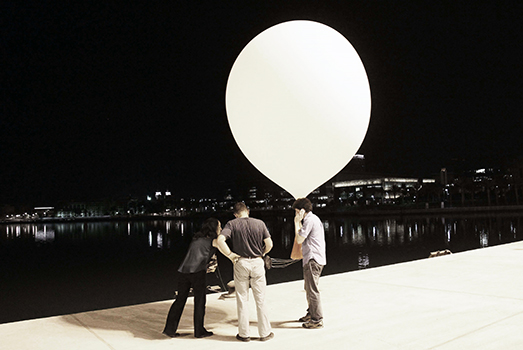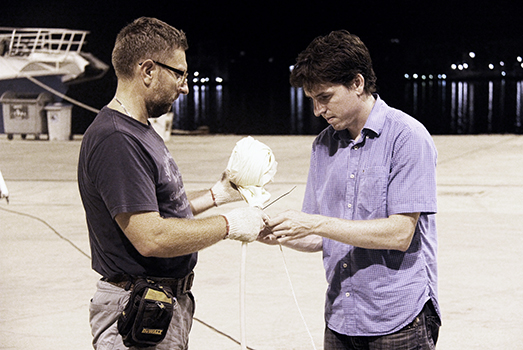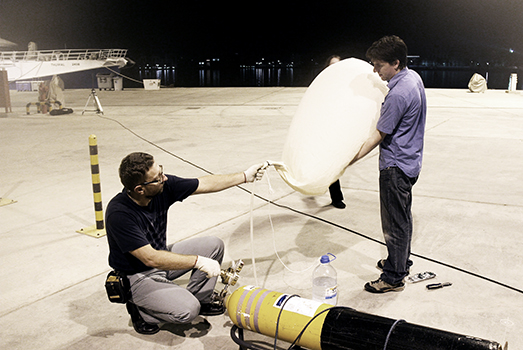Balloon-borne surveys of the atmosphere

Left to right: NASA LaRC postdoc Noel Baker, KAUST engineer Ilia Shevchenko, and NASA LaRC postdoc Tobias Wegner preparing to launch the weather balloon. Tobias Wegner is in communication with the General Authority of Civil Aviation (GACA) in Jeddah.
Aerosols are fine solid particles or liquid droplets in the atmosphere that can be produced naturally (as in fog) or from anthropogenic sources (pollutants). “We understand that they affect climate seriously, so they’re becoming more and more important as a research subject,” said KAUST Professor of Earth Science and Engineering Georgiy L. Stenchikov.
Balloon-borne surveys of the atmosphere from KAUST Video on Vimeo.
The leading aerosol of interest to Stenchikov’s research on the Arabian Peninsula is dust. “Dust affects all aspects of life in the peninsula. It affects atmospheric chemistry, air quality, industrial activities and impacts the energy balance on regional and global scales,” he noted.
Dust represents, among other things, a challenge for using solar energy in the region because dust gets deposited on solar panels and disrupts their effectiveness. Because of this, resources need to be expanded to keep the solar panels clean. Understanding the chemical and optical properties of dust is important not only to mitigate the negative effects of dust aerosols, but also to recognize the positive effects of dust deposition.
“Deposition of dust in the Red Sea provides nutrients for marine organisms and actually feeds the Red Sea ecosystem, so it’s important to know what chemicals are going in there,” said Stenchikov.
Conducting balloon-borne measurements
KAUST recently collaborated on a project with NASA’s Langley Research Center (LaRC) to launch six weather balloons from the premises of KAUST's Coastal & Marine Laboratory (CMOR). With the support of CMOR, the balloons were launched to an altitude of 35 kilometers. NASA LaRC is one of the biggest centers focusing on satellite observations and the analysis of climate and mechanisms of aerosols and the impact of volcanic eruptions on climate.

Ilia Shevchenko (left) and Tobias Wegner preparing to inflate the balloon.
Tobias Wegner and Noel Baker, two young NASA post-doctoral fellows from Langley Research Center, came to KAUST to conduct the experiment with Stenchikov and his team, which includes engineer Ilia Shevchenko and post-doctoral fellow Jishprakash Puthan Purakkal. Together, the team equipped the balloons with two sets of lightweight instruments to measure meteorological properties and to characterize the aerosols’ optical properties.
In addition to a radiosonde that monitors temperature, relative humidity and pressure, an instrument called a Compact Optical Backscatter Aerosol Detector, or COBALD, was also attached. COBALD uses high power light-emitting diodes (LEDs) in the blue and near infrared spectral range to detect the backscatter of light from atmospheric aerosols all the way from the surface to the stratosphere.
“Everything that’s in the atmosphere will scatter a light back. Because we have two wavelengths, we can get an idea of the size of the particles. Particles of different sizes will scatter more or less light in the different wavelengths. If it scatters more on the blue channel, it’s indicative of small particles, and if it scatters more on the near infrared channel, it’s indicative of bigger particles,” Wegner said.
The bigger picture
Stenchikov’s experiment is part of a bigger project initiated in 2011. Using satellite instrumentation, NASA’s Langley Research Center discovered an aerosol layer that formed over the Asian monsoon region, but the satellite data had problems - the resolution was too coarse to properly study the aerosol layer. A team led by NASA's Dr. Duncan Fiarlie and Dr. Jean-Paul Vernier set out on a 10-day field experiment in India last year to obtain in-situ measurements using weather balloons to better understand and characterize the aerosol optical properties and size distribution of the Asian Tropopause Aerosol Layer (ATAL).
The mission in India served to test the hypothesis that deep convection during monsoon season in India mixes up natural and anthropogenic pollutants from the surface all the way up to tropopause layer. These pollutants are processed in the atmosphere to form an aerosol layer. The satellite data seemed to indicate that the monsoon aerosol layer may get transported all the way to the Mediterranean and the Middle East.
One of the objectives of the NASA LaRC team that came to KAUST to launch the six balloons was to determine how much of the aerosol gets actually transported to the tropical upper troposphere and lower stratosphere over the Arabian Peninsula. However, the results of the experiments require further investigation to make definite conclusions on the effect of the monsoon system outflow.
While the scientists from NASA’s Langley Research Center are more interested in the upper atmosphere large-scale transport of pollutants, the KAUST group led by Stenchikov is more interested in the vertical mixing of dust from the Arabian deserts. The collaboration works and has great synergy because all useful measurements are obtained on the way up.

Before being launched, the balloon is inflated to an original diameter of 2 meters. At the height of its ascent, it will measure up to 10 meters in diameter.
Up in the air: coordinating with air traffic control
Through the help of KAUST's Government Affairs, the team obtained permission from Saudi Arabia's General Authority of Civil Aviation (GACA) for the launch of the six weather balloons. The balloons had to cross the path of airplanes below 14 kilometers, both on ascent and descent.
“It’s a relatively complex operation - more complex than we thought - because of intensive aviation operations in this area. We received a great professional support from GACA that was crucial for our balloon operations,” said Stenchikov. “The team was in constant communication with flight control to inform them of precisely when the balloons were launched, as well as the exact moment they passed through the flight pattern.”
“We can make a case for where approximately the balloon will travel on its vertical ascent based on weather forecasts and wind movements,” said Baker, NASA's post-doctoral fellow.
The Jeddah Airport air traffic control authorities asked the team to create a website to track the balloons’ movements at all times. The small desk the team set up at the CMOR building was essentially the project’s mission control, with the team equipped with laptops indicating a live map of airline traffic over Jeddah and the forecasted travel path of the balloon on each ascent. The balloon launches were all scheduled for 1:00 a.m. to coincide with minimal airline traffic.
It takes about 45 minutes for a balloon to reach an altitude of 14 kilometers, at which point it is safely out of Jeddah’s airspace. As the balloon ascends, it grows larger. From an original diameter of two meters at the Earth’s surface, a balloon can get as big as 10 meters across. Once it has reached its peak altitude of around 35 kilometers, it bursts, sending its payload earthwards into the Red Sea using a small parachute.
In addition to the experiments in India and at KAUST, balloons have also been launched in China. “The idea is to study the aerosol layer in the upper troposphere and to understand how this aerosol could mix into the stratosphere,” said Stenchikov. “The stratosphere is the chemical reactor of our global climate system. The chemical species coming from the troposphere will be processed by photochemical reactions and will eventually affect the chemical composition and optical properties of the atmosphere.”
- By Meres J. Weche, KAUST News

